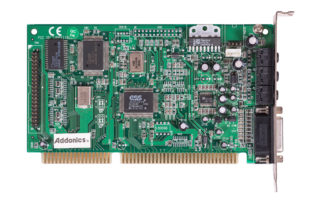Since Admos QS1000 is not actually a sound card, but a wavetable chip used in many different sound cards and daughter boards, this is going to be a short review. ROM size differs from card to card, as far as know there are two versions out there. One with half a megabyte and the second one with two megabytes of ROM. I assume there should be a difference in terms of quality between different cards with different ROM size. I’ve got only one card, though, cheap Labway with ESS ES1868f sound chip. This card features half a megabyte of ROM and 32 voice polyphony, so I don’t expect much, but it may surprise me.
I used generic ESS drivers, in which I set ports, IRQs and DMA to default values and also disabled joystick port. Then I cranked the master and synth volume up to the maximum values and down to zero for the rest. I don’t need to test ESS chip again, I’m here just for the SQ1000. It’s also unnecessary to test games without General MIDI support.
Doom and Doom 2 always work, it’s no surprise. However, something very strange happened when I ran Duke 3D setup. After setting up music card, you can test the card in the menu below. I of course set the card to General MIDI, but the test gave me a message, that it could not detect MPU-401. I tried to run the test again and all of a sudden it worked. So, I saved the settings, left the setup and ran the game. But the bloody game didn’t start and gave me the same message, that it couldn’t detect music card. I tried running the game over and over again until the music card was initialised and the game started normally with music. To make sure the card is still working, I had to try Doom again, which was working fine before. And as always, Doom worked. Then back to Duke again. To get it running I still needed couple of attempts. That was bloody weird, but let’s crack on with the test.
Just when I thought that everything is going alright, I entered Gabriel Knight’s setup. And again, setup didn’t detect any General MIDI device. I didn’t even try to re-run the setup, I just set the General MIDI manually and left the program. I was expecting same behaviour as in Duke’s case, but the game started fine and the music played fine as well. I tried to run the game again couple of times to make sure it’s working and it worked every time. Since Sierra usually uses the same setup program, I was tempted to try other Sierra games. And as I thought, they behaved pretty much the same.
Heroes of Might And Magic 2 uses Miles’ sound drivers as many other games and it always works, even with some more, let’s say, difficult, sound cards. This, unfortunately, wasn’t the case. This time it took me about 50 tries to set the sound card, and about 100 to get the game running. But in the end, it worked. And this is where it went downhill quite rapidly. I chose just games with Miles’ drivers and tested all of them. However, none of them worked, no matter how many times I tried. I was not sure if it’s the problem with the card, the QS1000 itself or the rest of the hardware. I tried different drivers, different HW, different HW settings, but it was still the same. Until I dug up an old Socket 7 board with Pentium processor. And voila, it works like a bloody charm.
For a cheap, half megabyte wavetable chip, I have to say, it doesn’t sound bad. Of course, it can’t compare with higher end cards, but it certainly can make a nice sound. In some games it sounds quite good, depending on used instruments. In others it sounded bland and lacked punch and sometimes, the instruments sounded a bit off to me. But in the end, it’s always in the ear of the listener.
I wouldn’t pay more than 20 quid for this card, it’s not worth more than that. It may be a nice addition to someone’s collection to play games with a bit different instruments or if somebody wants a cheap wavetable card and doesn’t want to spend more money. However, the issue with games not detecting the card on newer hardware is less than ideal. If you’ve got Pentium one and older, you should be alright. It’s a bit problematic on Pentium 2 and newer HW, though. I’d still like to test another card with QS1000 chip to see if the issue is the chip’s or the card’s fault, my bet’s on the QS1000.

